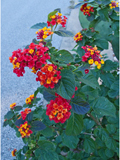
A spreading shrub, much branched from the ground upward, branches sometimes with prickles. Frequent in brushy places and in woodlands. Bark light gray to light brown, tending to flake off. Young twigs nearly square in cross section, covered with short hairs visible under a 10x hand lens. Leaves opposite, up to 2 1/2 inches long, broadly ovate, pointed at the tip, flattened at the base, upper surface rough to the touch; margins coarsely toothed, teeth broad, pointed or rounded. Flowers colorful, red, orange, and yellow, tubular with four flared lobes; in dense, rounded clusters with a leafy bract subtending each flower, at the ends of long paired stems (peduncles) usually extending beyond the leaves, appearing from April to October. Fruit round, fleshy, dark blue to black.
This species is a member of the verbena family (family Verbenaceae), which includes about 75 genera and 3,000 species of herbs, shrubs, and trees, mostly of tropical and warm temperate regions. Among them, teak is a highly prized furniture wood, and Vervain, Lantana, Lippia or Frog Fruit, and Chaste Tree or Vitex are grown as ornamentals.
More from USDA Plants Database »